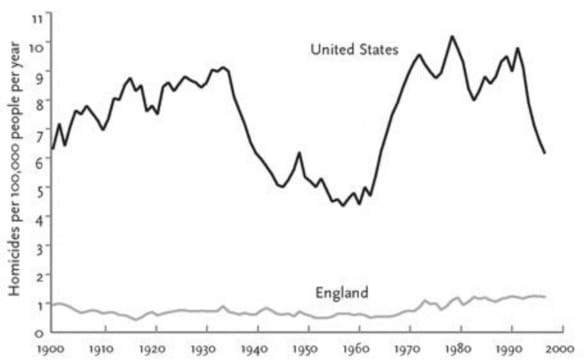
Previously, we have talked about how to win the gun control debate. You can read it here, but the Cliff notes are as follows:
- Calling the other side stupid doesn’t work, nor does spouting off facts at high volume.
- Listening is key, no matter how much you disagree with the other side. That’s because when you listen, you’re purchasing time that they will listen to you too. Oh, and people don’t care what you know until they know that you care.
- People don’t change their minds to your point of view in the middle of an argument. Like coffee, new ideas need time to percolate to be at their maximum effectiveness.
- We egotistical humans usually have to reach new conclusions on our own.
The bottom line is this. When arguing the topic, ask questions. Let the other side answer their own arguments. If they respond that they don’t know, you have a perfect opportunity to provide an answer that was asked for, not one shouted at them. Then let them go off and stew on that at their leisure. Who knows? Maybe they will change their mind.
Obviously, it’s important to know the answers to any questions you might ask, so here are a few to start the process.
Has murder really gone down in Australia Since Their Gun Ban?
In 1996, Australia implemented its buyback program. Well, “buyback” is a misnomer. People don’t like mentioning that it was a mandatory program. “You will turn in your guns, but we’ll be nice and pay you something for them.” Estimates indicate that this program collected somewhere between 650,000 and one million guns. Sounds great, right? Considering there were around 2.5 and five million guns to start with, the buyback only netted somewhere between a third and a fifth of the guns on the street. So, just to be clear, the “gun ban” left somewhere between 65 and 80 percent of all guns in circulation.

So, what did the buyback accomplish? Proponents point to “gun homicide” and “gun suicide” reductions. Hmm. It’s almost as if it’s worse to be killed with a gun rather than some other method. In fact, over the six years after the buyback, overall homicide didn’t change. Additionally, in two of those years, homicide went up. The other fact often left out of the debate is that “gun homicide” was already declining before the ban.
After those six years, overall homicide continued in a gradual decline, just like that here in the United States. Hold this thought for a second.
While homicide was settling down, gun ownership again increased in Australia. Now it’s actually higher than it was before the ban. Yet homicide didn’t go back up. If there was a causal relationship, wouldn’t one expect to see that?
The net-net: When 20-30 percent of guns were taken off the street, there was no observable reduction in murder rates. When guns came back into the population, there was no observable increase in murder rates.
What does that mean? There is no correlation much less causation.
Are a lot of people killed with “assault rifles?”
According to the FBI, in 2016, 374 people were murdered with rifles of any kind. That represents about a 19:1 ratio of handgun to rifle involvement. The FBI reports that 3,263 murders were committed using firearms of unknown type. Just to be really conservative, let’s categorize the right amount of unidentified guns, too. Using the 19:1 ratio, we can add another 171 murders to the rifle category. That brings the total to 545. Even if we assume that every single one of those cases involved a “AR” type rifle, then it’s still less than the number of murders committed by punching and kicking. That number was 656 in 2016. Knives were involved in 1,604 murders, and blunt objects were used in 472 cases.
So let’s summarize. Those “assault weapons” (quotes intended and you know why) were involved in fewer murders than bare hands and feet, less than two-thirds as much as knives, and about the same as bats, clubs, and hammers.
What do you think is involved with more deaths: guns, alcohol, or drugs?
In 2016, 15,070 people were murdered in the United States by any method. Of those, 11,004 involved the use of a firearm of any type. Also, in 2016, 10,497 innocent people were murdered by drunk drivers. Let’s look at one more data point. Just during the single year of 2016, approximately 64,000 people were killed by drug overdose. If you want to equate the two arguably self-inflicted death categories, drug overdoses, and suicides, there were 44,173 suicides in the US. Of that, the victim used a firearm in 22,018 cases. So, 22,018 people killed themselves with guns, 22,000 more killed themselves by other means, and 64,000 people killed themselves with drugs.
Does England Have Fewer Murders Than the United States Because of Gun Laws?
The short answer is that England and Australia have always had lower murder rates than the United States. For 100 years or more, that’s been the case. Guns or the fact that we call oil-boiled potatoes french fries while Brits call them chips has nothing to do with it.
To illustrate the point, let’s look at pictures. Here’s one from Steve Pinker’s book, The Better Angels of Our Nature: Why Violence Has Declined. It’s a clear view of the past 100 or so years or murder rate data per 100,000 people. As you can see, the United Kingdom has always had a murder rate of about one per 100,000 people. The United States rate has varied from a high of about ten down to the current level of about four per 100,000.
What’s not so clear on this graph is that the massive United Kingdom gun ban of 1997 didn’t cause the century-old murder trend to fall. In fact, it increased.

What does it mean? Perhaps we ought to look at other factors, like, oh, I don’t know, maybe the fact that our society is made up of a mishmash of immigrants (all of us) from all over the world. Just maybe the fact that we deliberately threw dozens of different cultures into a giant melting pot melee resulted in more internal strife than a country like England, which has been largely homogenous since the invention of porridge.
Correlation and Causation
About a million years ago, when dinosaurs and my Toyota Sequoia roamed the earth, I went to college and studied Economics. Not Home Economics, but the number kind where you use big words like regression analysis. I won’t claim to be any Economics theory expert, but I do have a basic understanding of causation and correlation. The irresponsible use of causation and correlation is what contributes the most angst to the gun issue debates.
People on the other side say things like “England has a gun ban and fewer gun murders. We have guns and more gun murders, so we need to be like England to solve the problem.” They claim causation, meaning that the gun variable between our two countries must be the only contributing factor to the difference in murder rates. They conveniently ignore the 17 trillion other variables that describe the differences between our two societies. They also conveniently ignore the historical data for each of our countries. Furthermore, they ignore fluctuations in historical data when a major variable, like a gun ban or increase in gun supply, is introduced. As we just discussed, England has always had a lower murder rate than the United States, so pointing to the current set of gun issues as the causing factor is disingenuous at best.
Let’s get it all out. If all this claimed causation existed, we would see results like the following.
- When England banned virtually all handguns and other types in 1997, murder rates would have fallen. They didn’t.
- When Australia “bought back” all those guns in 1996, murder rates should have fallen. They didn’t.
- When Australians gradually “re-added” all those guns to the streets, murder rates should have gone up. They didn’t.
- When the United States guns on the streets supply doubled over the past couple of decades, murder rates should have gone up. They didn’t. In fact, they fell by half.
When humans so desperately want to believe a point of view, we tend to latch on to artificial causation arguments too quickly. The world ain’t that simple.
About
Tom McHale is the author of the Practical Guides book series that guides new and experienced shooters alike in a fun, approachable, and practical way. His books are available in print and eBook format on Amazon. You can also find him on Facebook, Twitter, Instagram and Pinterest.
from https://ift.tt/9STsVet
via IFTTT

No comments:
Post a Comment